Suggestions for managing soil fertility
BIOMASS MANAGEMENT
In Rwanda, most farmers are too poor to buy enough mineral fertilizer to boost the productivity of all their land. Traditionally their only means of maintaining or restoring soil productivity is the biomass produced on their fields and on fallow areas, roadsides, communal forests, etc. Application of SPR and SWC methods (ditches) does not increase biomass production, and also reduces the productive area. Land husbandry, on the other hand, attaches great importance to improving biomass production and to careful management of organic matter so as to restore the essential nutrients to the soil as quickly as possible.
In the tropical African rain forest 8 to 15 t/ha of litter are returned to the soil each year. Under savannah 2 to 8 t/ha of leaves are returned to the soil, unless they are destroyed by fire or livestock! After clearing (burning off natural vegetation and putting the land under crops), the amount of organic matter in the topsoil horizons falls by 40 % in four to ten years, depending on how organic residues are managed - manure, compost, direct turning in, or mulching.
Under crops there is a fair amount of available biomass:
• maize and sorghum can leave 2 to 5 t/ha/6 months of residues, at present used for feeding stock or mulching the coffee plantation;
• soybeans, groundnuts and beans produce 0.5 to 2 t/ha of good-quality fodder;
• cassava and sweet potatoes provide 0.5 to 2 t/ha of biomass which can be used for feeding pigs or mulching the coffee;
• a banana plantation (3 × 5 m density) can produce 3.3 t/ha of stems and 2 to 6 t/ha of leaves which can be used as mulch or fodder;
• short fallow periods (a few months between two cropping cycles) and weeds provide 0.5 to 2 t/ha/yr of green matter.
AGROFORESTRY
This method can considerably boost biomass production on cultivated fields. Two hundred trees (Grevillea robusta, Cedrella serrata, Polyscias fulva, etc.) planted in or around fields can produce enough firewood for the whole family, plus 1 to 4 t/ha/yr of leaves and twigs very useful for mulching.
Planted every 5 to 10 metres, hedges of Calliandra calothyrsus, Leucaena leucocephala or diversifolia, or Cassia spectabilis, can provide 3 to 9 t/ha/yr of leaves (excellent fodder) and 2 to 7 t/ha/yr of firewood; in other words, more biomass may be produced on a cultivated field from crop residues, trees and hedges, than under primary or secondary forest. However, it is important to make sure that enough of it is restored to the soil.
BIOLOGICAL UPTAKE OF NUTRIENTS THROUGH AGROFORESTRY
If the soil is neither too acid nor too deficient in phosphorus, the shrubs chosen for hedges can fix nitrogen from the air. Depending on author and site (Balasubramanian and Sekayange (1992) in the eastern savannah, König (1992) and Ndayizigiyé (1992) around Butaré on the central plateau), cutting the hedges three times can bring up to the soil surface: 75 to 130 kg/ha/yr of nitrogen, 2 to 20 kg of phosphorus, 20 to 60 kg of potassium, and similar amounts of calcium and magnesium, depending on the richness of the soil in these elements an input of minerals close to that from 10 tonnes of farm manure. Apart from the litter provided by 200 trees per hectare, it is clear that agroforestry can make a considerable contribution to the organic and mineral balance of the soil in two ways: by significantly reducing nutrient loss through erosion and drainage, but also by extracting nitrogen from the air and through the uptake of nutrients carried by drainage beyond the reach of the roots of annual crops.
FIGURE
73
Effect of hedges of Leucaena
leucocephale and Calliandra calothyrsus
(1 m thick every 7 m) on average annual runoff (Kaar %), erosion
(t/ha/yr), hedge biomass production (kg/100m/yr) and harvests of
two cropping seasons at the ISAR station at Rubona in Rwanda on a
27% slope and on acid ferralitic soil (cf. Ndayizigiyé 1993)
Erosion as a function of annual rainfall
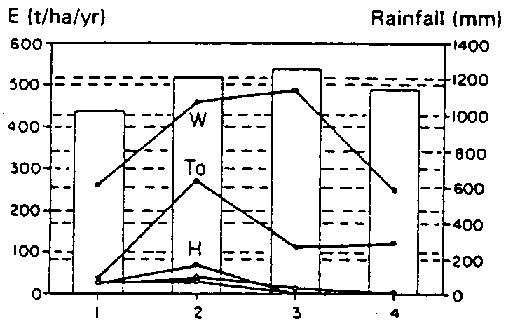
Runoff (Kaar = % of annual rainfall)
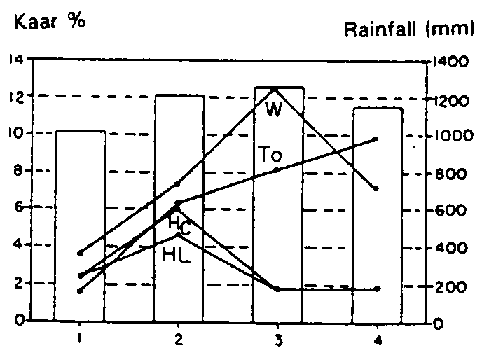
Hedge biomass production (kg per 100 m of hedge)
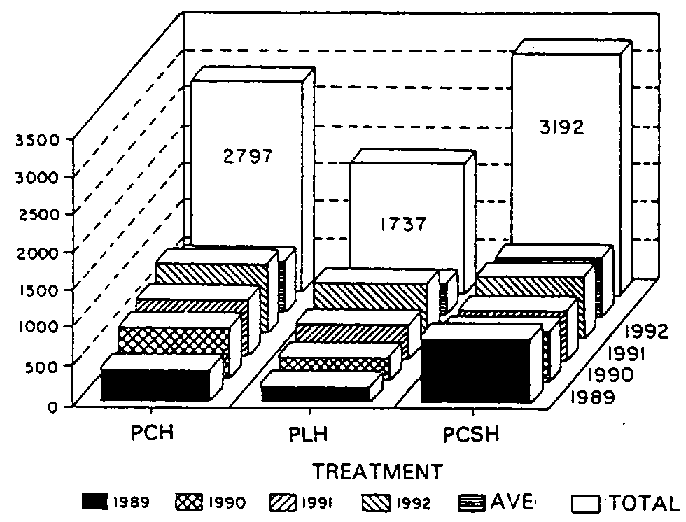
Bean and maize harvest (kg/ha) in the 1st season
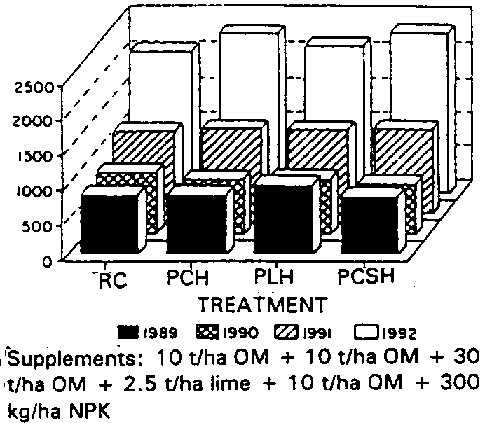
Sorghum grain harvest (kg/ha) in the 2nd season

W =
Wischmeier's standard bare plot
CH = Calliandra
hedge
P = production
LH = Leucaena hedge
RC = Regional control plot
CSH = Calliandra + Setaria
hedge
TABLE 41
Requirements of NPK,
lime and manure for each crop on the acid ferralitic soils of
Rwanda (cf. Rutunga 1992)
Crops |
N |
P |
K |
Lime, manure, inoculant |
Bean |
34 |
25-30 |
34 |
depending on cryptogamic diseases |
Soybean |
20-40 |
40-50 |
30-50 |
+ inoculant + lime if pH < 5 |
Pea |
34 |
34 |
34 |
+ inoculant + lime + manure |
Groundnut |
30 |
30 |
0 |
|
Sorghum |
60 |
60 |
17 |
at altitude + manure (+ lime) |
Maize |
78 |
42 |
42 |
|
Wheat |
88 |
42 |
42 |
|
Irrigated rice |
60 |
30 |
30 |
for two tonnes of paddy |
100 |
60 |
60 |
for six tonnes of paddy |
|
Potato |
50 |
100 |
200 |
+ lime + manure if at altitude |
Manioc |
100 |
50 |
100 |
|
Horticultural crops |
30-50 |
30-70 |
100-200 |
or 35 tonnes of manure |
APPLICATIONS OF ORGANIC MATTER AND MINERAL SUPPLEMENTS
Figure 73 compares the effects of three types of hedge, always at intervals of 7 metres, on erosion (t/ha/yr), average annual runoff (Kaar %), biomass production from hedges, and cereal production.
Biomass. Calliandra hedges give twice as much biomass as Leucaena (4 to 8 t/ha/yr). Prunings spread on the ground three times a year cover 80% of the surface with Calliandra and 40% with Leucaena. However, after two weeks all the small leaves have gone, digested by soil microflora, leaving only the twigs - which children can collect as firewood. Perhaps other shrubs should be investigated for intercropping.
Runoff. Apart from the first month after planting, the soil is so well-covered that after two years runoff is negligible: 12% on bare soil, 8 to 10% under traditionally grown crops, 1 to 2.5% under crops with hedges every 7 metres. Runoff is serious only in the case of the long rainstorms of the second season under sorghum on a waterlogged soil. -Maximum daily runoff reaches 68% on bare fallow, 20 to 35% under crops.
Soil loss. Sheet and rill erosion decreases from 450 t/ha/yr on bare fallow to 80 to 120 t/ha/yr under traditionally grown crops, and 1 to 2 t/ha/yr under crops two to three years after planting hedges. It should be noted that the crops received 10 t/ha/yr of farm manure (and even 90 t/ha in the third year), although even such a high input of manure was not enough to bring erosion down to acceptable levels. However, while erosion tends to increase from year to year under traditional methods, it decreases on plots protected by hedges proportionate to the slope of the land (from 27 to 15%).
Impact on crop production. In the first year harvests were much the same, indicating that the plots were similar at the outset. In the second year, despite 10 t/ha of manure, yields fell from 10 to 30%. In the third year, following an application of 30 t/ha of manure, yields climbed from 32 to 53 or 68% in the fields with hedges. It was only in the fourth year, when 2.5 t/ha of CaCO3+, 10 tonnes of manure and N51, P51, K51 were applied that yields increased markedly from 500 to over 2000 kg/ha of cereals and up to 2318 kg/ha between the hedges, despite the space taken up by these hedges (15%). Second-season sorghum production remained poor (420 to 640 kg/ha) except after liming and supplementary mineral applications (up to 1544 kg on the plots with hedges).
In this trial on acid ferralitic soil, it seems that even if erosion and runoff are brought under control, yields still continue to fall. Ten tonnes of manure plus six tonnes of pulse mulch were not capable of increasing yields of cereals and beans, because the plants, the soil, the animals and the organic manure are deficient in the same elements (especially P and N). However, yields tripled and the erosion control measures paid off after the pH was corrected (2.5 t/ha/3 yrs of lime was enough to eliminate aluminium toxicity), and supplementary minerals applied (60 units of NPK were enough for the cereals).
So far it seems that farmers are becoming steadily more interested in hedges, but more as sources of dry-season fodder and boundary markers than as erosion control measures. They have not fully grasped all that is involved in the hedge system, particularly the need to cut back roots and branches to limit competition with crops.
RESTORING SOIL FERTILITY
Outside the volcanic zones, desaturated ferralitic soils are very acid, often exhibit aluminium toxicity, and have excellent drainage, which means that there is a high risk that fertilizer will be leached out in drainage water, especially if runoff is suppressed without intensifying cropping. In such circumstances, farmers will reject soil conservation as leading to no increased return for their work. It is vital that soil conservation, water storage and fertility restoration be introduced simultaneously if there is to be any significant improvement in yields.
The following six rules must be followed if soil fertility is to be restored in one or two years:
• control of runoff and erosion;
• deep subsoiling in order to reorganize rooting;
• stabilization of macroporosity by digging in organic matter (or lime) and by a crop with a vigorous rooting system;
• correction of the pH (pH 5);
• revitalization of the soil through applications of manure or compost (3 to 10 t/ha/2 yrs);
• correction of the main soil deficiencies, or at least provision of the essential crop nutrients.
MAINTENANCE MANURING
As was seen in the Rubona trial (Figure 73), once erosion has been brought under control and the physical, biological and chemical fertility of the soil restored to an acceptable level, plants still have to be fed (localized manuring) as and when needed (staggered doses), depending on crop production goals (N = 40 to 160 kg/ha/yr + P = 30 to 100 kg/ha/yr + K = 20 to 100 kg/ha/yr) and the risk of periodic leaching. In practice, organic residues have to be better managed and the mineral supplements vital to the crops added, as ferralitic soil can store very few nutrients and little water.
Rutunga (1992) has noted that on Rwanda's poor land, liming (2 to 5 t/ha) should be done every three years, and organic manure applied every three crop cycles. On soil of average richness, liming makes little or no difference, but mineral and organic manuring does. As for rich volcanic soil, weak doses of NPK have so far produced only slight improvements in yields.
CONCLUSIONS ON LAND HUSBANDRY IN RWANDA (Plate 32) In the heavily populated tropical mountains of Central Africa, the risks of erosion (300 to 700 t/ha/yr) and degradation of soil fertility increase with slope and population density (150 to 800 per km˛) (Figure 74). Some production systems can keep erosion at an acceptable level: mulching under coffee, banana or cassava, large contour ridges with permanent plant cover, green manure covering the soil surface, reforestation with species that provide good litter. Radical or gradual terracing (1000 and 100 days' labour respectively) and other erosion control structures are less effective than biological systems (grassed banks, hedges, etc.) and require more upkeep and space. Agroforestry (e.g. 200 trees per hectare plus hedges every 5 to 10 m) can control erosion (1 to 3 t/ha/yr), produce fodder and mulch (4 to 10 t/ha/yr) and take up nutrients from deep in the soil (N 20 to 100, P 10 to 20, K 2 to 40, Ca + Mg 20 to 40, etc.), with a reasonable amount of work (10 to 30 days per year). Animal husbandry can enhance the benefit of this biomass, since dung is one of the keys to fertilizing ferralitic soil, which is like a sieve. However, despite applications of 10 t/ha/yr of dried corral-dung and 4 to 8 t/ha of pulse mulch, land productivity has remained very low (400 to 800 kg of beans, maize and sorghum, 3 to 8 t/ha of cassava). If the challenge of doubling production before the population doubles (17 years) is to be met, it is vital to propose a technological package comprising management of both water and soil: cisterns, hedges, organic fertilization (mulching, green manure and improved farm manure) with a mineral supplement (40 to 100 kg/ha/yr of NPK, and 2 to 5 t/ha/3 yrs of lime). SWC is not enough. It
may be noted that the densest populations in the world
live in "multi-storey gardens" where the
positive interaction between animal husbandry, crops and
trees is carried to the furthest extreme. In Africa, much
remains to be done before achieving the intensity of
production found in the gardens of Asia. |
FIGURE 74 Erosion risk and suggested improvements for the granito-gneissic hills of Rwanda
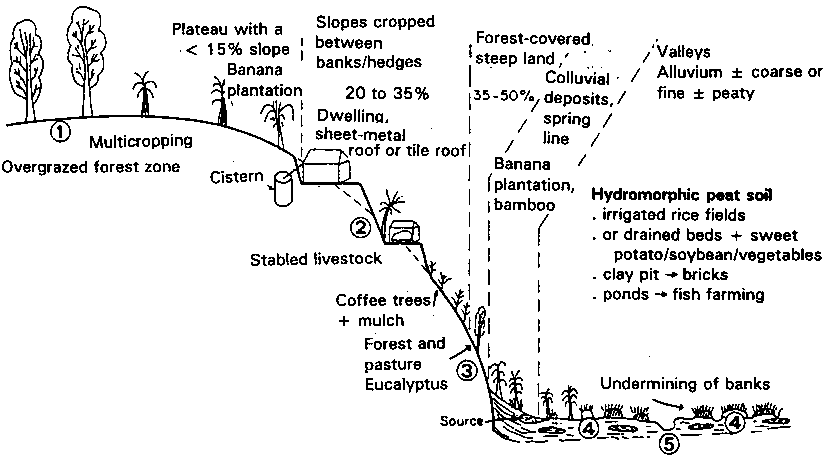
Ferralitic acid soil
• permeable
• heavy leaching
• P-N-K-Ca-Mg deficiency
• good resistance to erosion
(1)
Rainsplash and rills (r) scouring of topsoil
(2) Rainsplash, rills (r) gullies, compaction of tracks
(3) Undermining of banks by
river, gullies and mass sliding
(4) Deposits with very
irregular texture: gravel-sand, clay-peat - drainage necessary
(5) Torrential river with
very varied flows and solid loads
Problems
- How to feed a very dense population living on very poor soil
- How to evacuate excess water from very steep cultivated slopes
- How to improve management of bottom lands
Attempted improvements
1 Drain bottom lands, introduce streambed cultivation: very difficult when only part of the basin is being treated.
2 Slopes: stabilize ground with hedges every 10 m and 200 trees/ha.
(r) production of fodder, firewood, mulch;
(r) stabilize the ground against sliding (roots), runoff/mulch;
(r) trees bring organic matter and nutrients to the surface;
(r) grassed banks, and hedges.
3 Absolutely necessary on these poor, acid soils: biomass management + mineral applications:
(r) manure/compost pits + lime and P2O5 + ash to raise the pH to > 5;
(r) staggered spot application of a mineral supplement for plants.
4 Transform banks into fodder belts stabilized by legume hedges + grasses and tillage detritus (roots, twigs, stones).
5 Improvement of tracks: generalized grassing, and drainage to cisterns or sedimentation pits planted with bananas.
6 Need to organize the marketing of agricultural products (tracks, etc.) and inputs.
Chapter 12. A new approach to erosion control in Haiti
AN EXAMPLE OF A CALCAREOUS-BASALT TRANSECT IN THE HILLS OF SOUTHERN HAITI
Bernard
Smolikowski, Director of PRATIC (1988-1992),
Aid Mission to
Praďa, Republic of Cape Verde
Eric Roose, Director
of Soils Research, ORSTOM, Montpellier, France
Michel Brochet,
Director of Studies, ESAT/CNEARC, Montpellier, France
The situation
Analysis of local conditions
Farmers' traditional strategies and their limitations
Control measures
A SPECIAL CONTEXT
Since the 1950s, Haiti has been experiencing accelerated degradation of its rural land and natural resources. Although agriculture is undergoing a particularly difficult crisis, it still constitutes one of the dynamic forces of the country's economy.
Malnutrition in the countryside, the decline in exports (50% in the last 10 years), a major rural exodus and the inability of families to save are thrusting Haitian farmers into a cycle of decapitalization that will be hard to break, for the very low farm income (falling from $450 to $250 in 1992) no longer allows most of them to renew either their livestock or their implements. Furthermore, the rising population has aggravated pressure on land, resulting in increasingly frequent cropping and reduced fallowing of the same land, leading in turn to overgrazing and hastening soil degradation.
This is seen not only in lower fertility, but also in accelerated soil loss, since the components of the physical environment are naturally fragile: 60% of cultivated land is on very steep mountain slopes (20 to 80%), with frequently violent rainfall conducive to runoff. The outcome of all these factors is lower returns on labour, in the face of which charcoal production seems a good alternative to improving farming income. This has led to uncontrolled deforestation, accelerating the deterioration of the natural resources that underpin agriculture.
The consequent decapitalization, accompanied by a loss of social cohesion, forces farmers into a survival mentality, making it hard to approach land management as a group effort (control of livestock grazing and of woodcutting), although this is a sine qua non of successful development or erosion control efforts.
THE FAILURE OF SO-CALLED "MODERN" EROSION CONTROL STRATEGIES
From the 1960s until 1990, national authorities were advised by international bodies and donors that the answer to the crisis of the rural sector lay in solving natural resource conservation problems. The special situation in Haiti encouraged implementation of a large number of schemes and projects based on a "modern" strategy of rural development, thus turning this country into a kind of erosion control laboratory.
Unfortunately, this approach to improvement and development nearly always led to closing off large areas to livestock, or else to soil and water conservation schemes (SWC) that turned erosion control into an isolated experience. Such projects achieved only mixed and questionable results, and often ended in failure.
The strategy adopted concentrated on developing a unified area, usually a watershed, emphasizing the physical coherence of the various processes. It gave priority to infrastructure installations (roads, feeder roads, gully control, contour channels, dry stone walls, radical terraces) with most of the work being done with the help of the local populace in exchange for some remuneration (in money or kind). And it was meant to have an almost immediate effect on the conservation of natural resources.
Failure sprang basically from the fact that "general interest" was the paramount factor, legitimizing infrastructure development and making soil conservation (SWC) the prime objective although Haitian farmers had a very different view, and saw such projects simply as ways of ensuring an immediate income, even though the proposed conservation techniques failed to offer short-term improvements in yields and income.
Furthermore, there is no direct relationship between these techniques and the set of constraints that farmers have to face. This gap between proposals and constraints arises from a deep ignorance of the farmers' economic perspective, of how farming systems work in general, and of land tenure issues in particular.
The latter entail an inheritance system that encourages fragmentation and joint ownership, aggravating land insecurity and the danger of food insecurity as farm plots shrink in size.
The installation of erosion control structures means sacrificing some of the already limited arable land, with no possibility of improved yields for many years to come. The extra work required for their upkeep is work that only the farmers themselves can assure. Furthermore, these techniques neither reduce degradation on the land between the structures nor improve productivity. They are not very effective, and sometimes increase such risks as overflow, gullying and landslides by upsetting ecological balance on the slope. To avoid these constraints, erosion control structures are often built on land marginalized by farmers.
Similarly, research work focuses more on selecting species and on the depth or inclination of terraces than on ways of integrating trees or mechanical structures into traditional farming systems.
Project organization needs revision, and a change from the approach whereby the population is used as a labour pool without any real participation. Project monitoring and evaluation are also needed.
There is thus a complete divergence between the objectives of a project that prioritizes the capital development approach and the objectives of the people involved (who are rarely consulted). The situation is now such that it is no longer enough either to protect or to conserve the soil. The population is growing rapidly, and production must be increased without degrading the environment.
A NEW PARTICIPATORY APPROACH: THE SALAGNAC/AQUIN PROJECTS AND PRATIC
Another approach, based on rural development, has been worked out since 1985, aiming mainly at solving the people's immediate problems (food security, improved yields, better returns for work) through better land use using techniques, suited to the Haitian context, that safeguard the environment and land resources. Soil and water conservation, from being an end in itself, becomes a means of establishing stable production systems.
This approach, now known as land husbandry, seeks to improve infiltration on fields so as to increase biomass production (and hence yields) by providing better soil cover and reestablishing the balance of organic and mineral matter in the soil. It attempts to reduce the impact of erosion and sediment transport by modifying production systems, while ensuring that farmers take responsibility for their own environment.
It was adopted by two French aid projects, Salagnac-Aquin (1978-92) and PRATIC (1988-92), concerning the Petite River transect Nippes-Salagnac-Aquin (Figure 75), with activities1 aimed at encouraging intensification and diversification of farm production while stabilizing slopes: new cash crops, increased foodcrop yields on land with the best potential. The goal was to relieve the most vulnerable land from cropping pressure (frequent tillage and overgrazing) and transform it into a forest- and fruit-tree farming area, improving animal husbandry conditions, etc. It was based on the following principles:
• Farmer participation right from the project design stage. This is a decisive factor for protection activities and vital to project success, as the farmers are the only people who can guarantee upkeep of erosion control structures at the plot level and/or on the slope as a whole.
• Reinforcing traditional methods of soil and water conservation. Haitian farmers have themselves adopted traditional survival strategies to control erosion and boost soil fertility.
• Selecting zones that have retained maximum agricultural production potential.
• Intervening on individual plots and slopes, and then, whenever possible, at the watershed level. Erosion control thus focusses first on the plot, then on the farm, and finally on the whole area. Piecemeal treatment of individual plots is no alternative to treatment of a watershed, for they require different strategies (the rural development and capital development approaches), which should in fact be complementary.
• Combining soil conservation activities with convergent activities that allow enhanced production systems (intensification and diversification of cropping, improved animal husbandry, creation of savings and credit).
• Setting up a system of contractual relations with precise definition of the conditions of intervention, and of farmer-project relationships, with clarification of the activities that are the strict responsibility of each farmer (improvements on individual plots), those that are the responsibility of the rural community (roads, feeder roads, communal cisterns, gully control), and finally the commitments of the project.
• Allowing for planning, monitoring anal evaluation (measuring the effects). This type of programme will require much time (8 to 10 years) before it has any noticeable effect on production systems or can modify practices while ensuring that farmers take responsibility for management of their environment. It has three necessary phases:
• 1st phase: analysis of local conditions in order to discover the potential and limitations of the physical environment, including the processes of soil degradation (where, when and how they arise), but also the farmers' traditional methods of farming their land and managing water and fertility. This analysis will foster dialogue with the communities and help build trust.
• 2nd phase: on-site trials in order to establish technical terms of reference (comparing traditional techniques with the proposed techniques).
• 3rd phase: evaluation of the results by both communities and experts, prior to planning intervention on whole hillslopes and watersheds.
1 These activities were abruptly broken off following the suspension of aid after the September 1992 coup.
FIGURE 75 Map of Haiti
